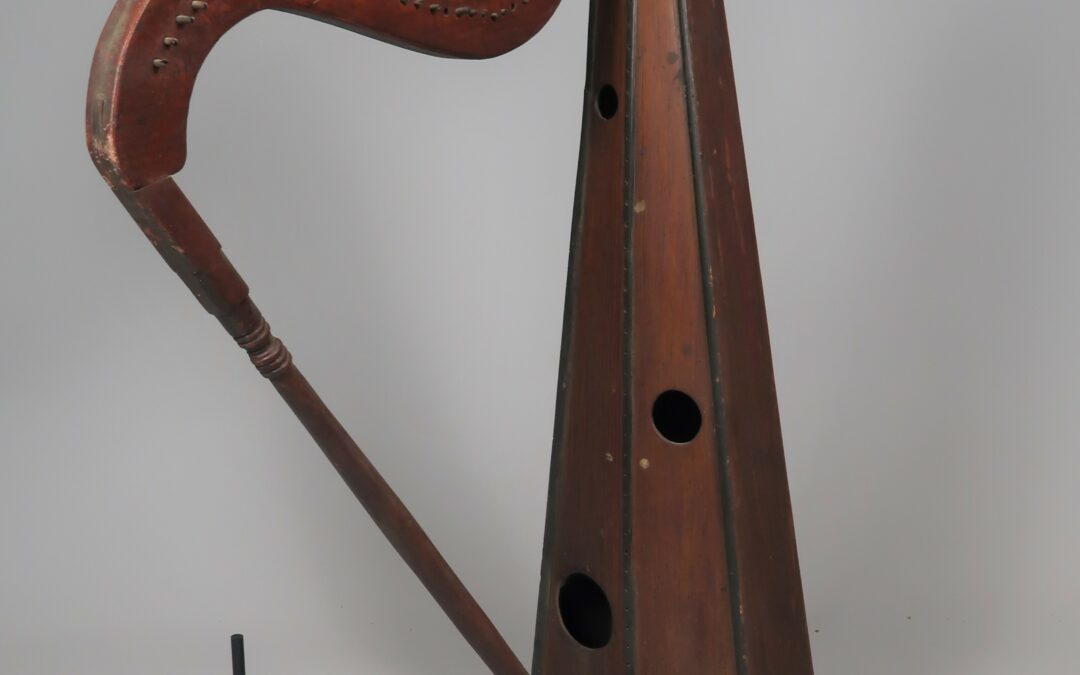Spanish colonizers first introduced the harp to Central America. Harps came in two forms, the “harp of one order” (el arpa de una orden) and the “harp of two orders” (el arpa de dos órdenes). Originally used to instruct Native communities on European-style music, Indigenous Americans appropriated the harp for their own traditional ceremonies and regional practices. It was later replaced by the more portable guitarrón (bass guitar) in the Mariachi group.¹
This harp is an example of a “harp of one order.” According to the original Sutter’s Fort catalogue card, Mexican musicians played this harp in the dance halls in mining towns during the Gold Rush Period. The harp was made in Mexico and brought to San Francisco by an unknown player in 1848. It later fell into the hands of an early Sacramento resident, who donated it to Sutter’s Fort between 1900 and 1930.
The harp itself is 35 inches long x 14 1/2 inches wide x 39 7/8 tall. It no longer has its strings.
¹ Samuel Milligan, “The Spanish Harp in Colonial San Antonio,” The American Harp Journal, Summer, 2009, pg. 28-44.; Alfredo Rolando Ortiz, “History of Latin American Harps,” Harp Spectrum: Exploring the World of Harp, Accessed Aug 3, 2023.; Sergio Alonso, “Arpa de Mariachi,” Mariachi Publishings: Education Resources, Accessed Aug 3, 2023.
The video below by renowned Mariachi Vargas harpist Julio Martínez provides a demonstration of how a similar harp can be played.
A special Thanks to the Authors of this Series
Collections Highlights from September 2023 to March 2024 are co-authored by Emma Silverman (Cultural Resources Program Manager), Judy Russo (Museum Technician), and Morgan Braun (Park Interpretive Specialist), based in part on research files assembled by State Park curators over decades.
Click here to receive this series directly to your email!
Overview of Sutter’s Fort State Historic Park Collection
The Sutter’s Fort State Historic Park Collection is one of the largest in the State Park system, with over 50,000 objects including photographs, diaries, letters, maps, paintings, furnishings, tools, and housewares. The Collection contains items that directly testify to life at Sutter’s Fort in the 1840s such as John Sutter’s magnifying glass, likely used to inspect the nugget that sparked the Gold Rush, and a Spanish-style plow used by Native people who were forced to labor for Sutter. However, the bulk of the collection, traditionally known as the “Pioneer Collection,” was amassed in the first part of the twentieth century and represents the experiences of Euro-American settlers and the history of the formation of the State of California.
While there are many artifacts typically on display at the historic site, most items from the Sutter’s Fort collection are housed at a state of the art curatorial facility on the former McClellan Air Fort Base. This facility is called the Statewide Museum Collections Center (“SMCC”). The talented California State Parks Curatorial team cares not only for the exhibits at the Fort, but for this huge collection offsite.

